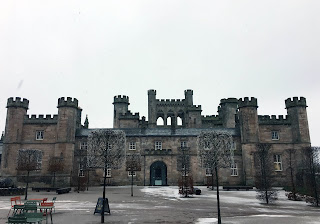Visit to Lowther Castle, Penrith - 29th January 2019
 |
| The Courtyard at Lowther Castle |
On a snowy winter’s day, we travelled from school to Lowther Castle and met the Creative Conversations group again. Cassie gave a short talk about the history of the Castle and Lowther family.
She told us that the Lowther family has been on-site since as early as the 12th century. A man named Dolfin, who is believed to be of Viking descent was the first to build on this land in 1150. He chose the area for its beauty and wildlife. The name Lowther comes from Old Norse meaning ‘foaming river’.
The building was
then renovated and improved in 1691, making it Lowther Hall. This was
a much grander home with beautiful gardens to compliment it.
Unfortunately, the building did not last long as it burnt down in
1718 due to the chimneys not being swept. It remained a charred
shell and when the then owner Richard Lowther died in 1751 without an
heir, the estates passed to his cousin
James Lowther (known
as Wicked Jimmy), which included the coal fields around Whitehaven
and West Cumbria.
The coalfields had
come into the family in the 17th century when Sir
Christopher Lowther, second son of Sir John Lowther II took on the
manor of St Bees. An entrepreneur he had a career in trade sending
many goods including coal to Ireland. After his dealth, the estates
were passed to his son – also John – Sir John Lowther (1642 –
1705) – although he suffered from ill health and lived in London,
he was involved in the mining industry and introduced many
innovations, one being the cartways to move coal.
 |
| Coal wagon on rails - cartways |
We had learned from
our visit to the Beacon that coal from the coal pits around
Whitehaven had earned Sir James Lowther £40000 a year (£8 million
now) and in 1761 he married Lady Mary Stuart, herself a coal heiress.
With this wealth,
the castle was re-built in 1806 and is the current building you see
now. It took around 6 years to rebuild and cost £77,000 (which in
today’s money is around £6 million). The castle had 365 rooms and
was spectacular to see.
Huge amounts of
money was spent – one room was lined in mohair – panelling
was guilded in gold and ceilings painted by the best money could buy –
Antonio Verrio – who had worked at Versailles, Windsor and Hampton
Court.
 |
| silver on show at exhibition |
One visitor around
this time in 1809 was Joseph M.W. Turner RA who stayed as a guest for
approximately a month. His painting of the Castle is included in the
exhibition.
 |
| Stencil design from wall in yellow room |
The last earl to
live at the castle was the 5th Earl (also known as the
Yellow Earl).
He was a very
flamboyant man who loved to live the life of luxury. He was called
the Yellow Earl because he loved the colour so much. Everything was
yellow, including his cars and dogs.
He was the chairman
of the car rescue service, the AA, who have made their trademark
colour and logo, yellow.
Due to the Earl’s
spending the bank account was more or less empty and in the 1930s,
his trustees suggested he and his wife could no longer live in the
castle.
During the second
world war in 1942, the Castle was requisitioned by the army who spent
three years experimenting with a secret weapon – the Canal Defence
Light. This light mounted on the tank’s turret was 13 million
candlepower and with its particular arc would blind the enemy
enabling friendly forces to move unseen.
When Lancelot
Lowther inherited in 1944 following death of Yellow Earl, the estate
finances were on their knees. The house had dry rot and damp and the
gardens had overgrown. He was not a young man and post war, he
decided the contents should be sold.
 | |
| picture from exhibition showing furniture being removed from great hall to be sold |
In 1947 over four
months the largest country house sale at the time saw 7689 lots put under the
hammer and dispersed forever.
In 1953 James
Lowther (Earl of Lonsdale) inherited the estate from his grandfather.
The castle was going to ruin, the gardens were a wilderness. With a
£25 million inheritance bill, he tried to sell the castle but the
people of Penrith objected. To reduce costs he opted for partial
demolition and removal of the roof and the land was used for
agriculture and forestry.
 |
| pictures showing main building roof removed |
In 2006 Lord
Lonsdale sold the castle to his son Jim Lowther for £1. The Castle
and grounds are now undergoing a major restoration and in 2011 opened
for the first time since 1938.
 |
| picture from exhibition showing start of renovation |
The gardens are open
to the public with routes covering 130 acres. It is well worth a
visit but sadly when we were there, due to snowy paths we did not
venture into the gardens. However, we thoroughly enjoyed our visit
and after spending time in the exhibition, we all returned to the
stables where we ate our lunch before returning back to Carlisle and
Distington.
 |
| fire pit in courtyard featuring dragon from Lowther shield |







Comments
Post a Comment